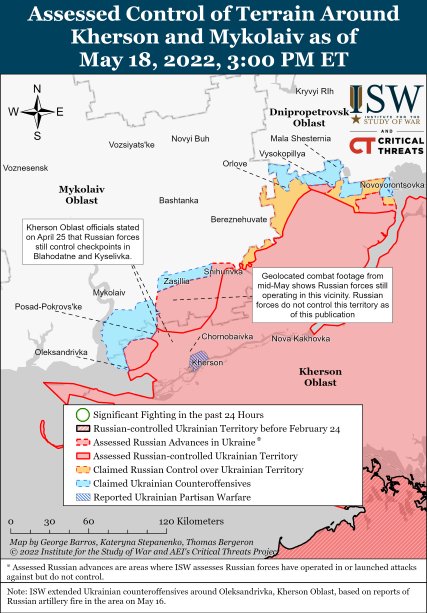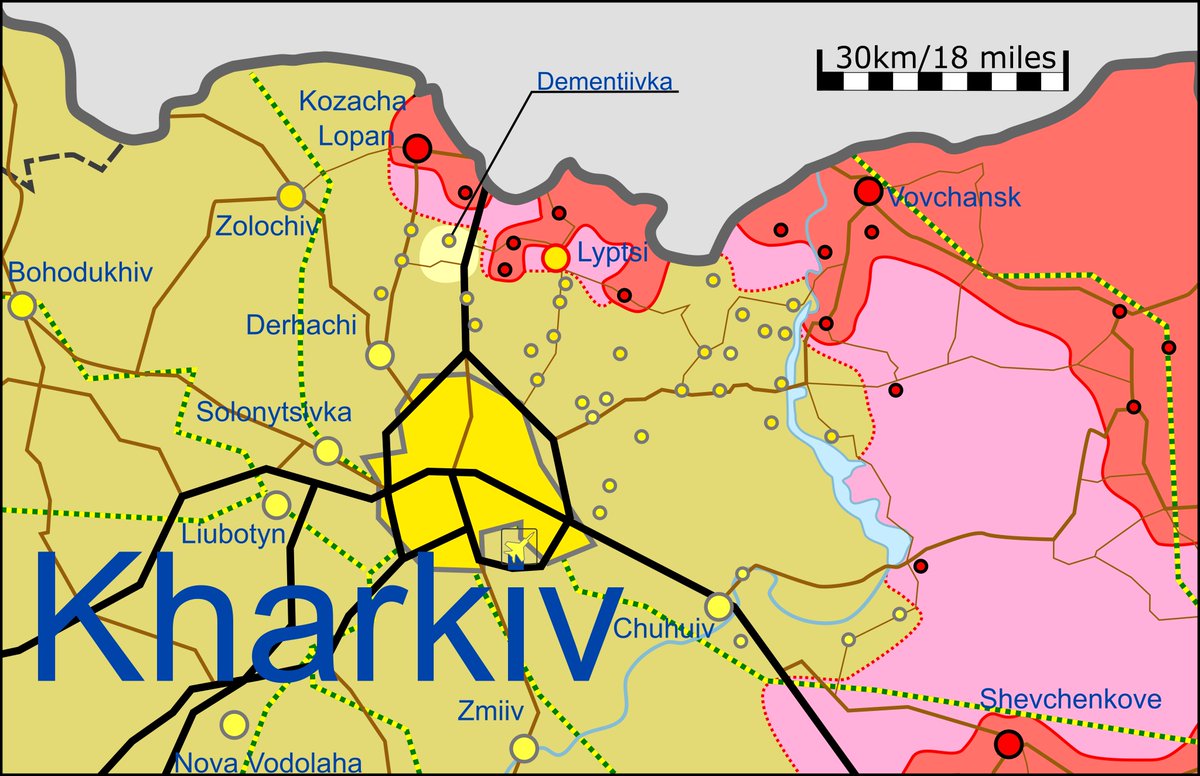Today marks the end of the twelfth week of Putin’s War in Ukraine. As I’m going to be away for a few days, indulging my passion for the Seven Years’ War and sharing whiskey with good friends, I’m going to leave my overview of where the war stands today.
First, a quick overview. This is an animation of the first 80 days of this war.
This week, a lot of new equipment started hitting the war zone. Here are former Polish Army T-72s, newly upgraded with a reactive armor package (I think with modern anti-armor munitions, this is a night light and comfort blanket for tankers, but whatever).
⚡️The Polish tanks handed over to the Armed Forces of Ukraine are already at the forefront. This is how the T-72M1 and T-72M1R look like with ERA elements already installed. pic.twitter.com/JzMfsXLR0x
— Flash (@Flash43191300) May 19, 2022
American M-777 howitzers are having their impact felt.
M-777 Howitzers in action. Part of the United States’ most recent $800 million care package for the Ukrainian Armed Forces. All but one of the 90 Howitzers sent by the United States are now in Ukraine, many now deployed on the front lines. @GeneralStaffUA pic.twitter.com/B012LeV8uT
— U.S. Embassy Kyiv (@USEmbassyKyiv) May 15, 2022
Lighter MRAP-style vehicles have started to appear.
#Ukraine: A Bushmaster MRAP in use by Ukrainian forces, these were supplied by Australia. This picture was taken in the east, meaning it is most likely active in combat. pic.twitter.com/RNyQbwjVS9
— Arslon Xudosi 🇺🇦 (@Arslon_Xudosi) May 15, 2022
Both British and US sources claim that multiple senior Russian officers have been relieved for poor performance. So maybe we should adopt this policy.
(1/7) In recent weeks, Russia has fired senior commanders who are considered to have performed poorly during the opening stages of its invasion of Ukraine.
— Ministry of Defence 🇬🇧 (@DefenceHQ) May 19, 2022
You need to fire General Putin.
Senior Russian commanders fired for military failures – The Times of London https://t.co/HDOk8pZxEr
— John A. Clark (@jclarkcni) May 19, 2022
And eyebrows were raised when Ukraine President Volodymyr Zelensky replaced the commander of the Territorial Defense Force without explanation.
1/ so… every one reporting “Zelensky replaced the commander of the Territorial Defense Forces of the Armed Forces of Ukraine” 15/05/2022
not saying : Zelensky dismissed Yuri Galushkin from his post.The reasons for the change of commander are not reported. #Ukraine #UAarmy
… pic.twitter.com/l4DgZwQm4C— J. comme JéJé 🇫🇷 🇺🇦 #UkraineMap (@HeliosRunner) May 16, 2022
Allow me a moment of speculation. There is no doubt that General Galushkin did yeoman’s work in preparing the Territorial Defense Forces (TDF) for the early days of fighting (keep in mind, it only came into being on January 1, 2022). Or at least his staff and subordinate commanders did. There could, however, be some areas of friction with the higher command echelons. The TDF is assigned to a local area, sort of like a “home guard” unit in the Civil War. I can imagine there is pressure from above to move these forces from where the Russians aren’t to where they are. There have been complaints on social media from alleged TDF members of being transferred from their home regions to those under attack. It is always possible that an effort is being made to convert some TDF units to the regular army, which the TDF and Galushkin, as its founder, might have resisted.
A second possible point of friction is the 16,000 foreign volunteers who have flocked to Ukraine. To give them protection under the Geneva Conventions and the International Convention against the Recruitment, Use, Financing, and Training of Mercenaries, these men had to be enlisted in the Ukrainian Army. Some of the foreign elements are performing very well, and some of the volunteers have no military experience. Blending foreign soldiers into the TDF structure could be challenging. And, whenever you are evaluating general officer assignments, never exclude raw politics. Generals play the game, as well as most politicians.
Let’s take a look at the map and refer back to my post; Ukraine’s Future Depends on These Three Fights That Russia Must Win.

Credit: Critical Threats on Twitter.
Kherson

Credit: Critical Threats on Twitter.
The fighting around Kherson has been low-key. The Ukrainian offensive there is making small gains. Reports are of Russian troops preparing defensive positions. There has been no further talk of an amphibious landing between Kherson and Odesa. The “terrorist” attacks in the Russian-occupied Moldovan region of Transnistria have ceased. Ukraine has assigned a brigade-sized force to keep Transnistria under observation. That force, along with the territorial defense forces, is more than sufficient to deal with any threat in that direction. Read Putin Decides to Widen the War With Ukraine to Achieve His Objectives for details.
There have been increasing numbers of reports of the assassination of Russian troops in Kherson and Melitopol. In addition, a Russian armored train was attacked and disabled near Melitopol earlier in the week.
MELITOPOL TRAIN: Ukrainian SOF are reported to have sabotaged an armored train carrying RU troops near the occupied southern city of Melitopol. News of this attack came just hours after word that several ‘high ranking’ RU officers were killed by partisans in the city center. pic.twitter.com/gbFAZ1nwX7
— Chuck Pfarrer (@ChuckPfarrer) May 18, 2022
READ RELATED: Turkey says no to Finland, Sweden in NATO
Recall that Ukrainian special operations forces have dropped a bridge near Melitopol.
Ukrainian SSO took credit for destroying that rail bridge near Melitopol in Russian-occupied territory. https://t.co/s2BNcJPX6N pic.twitter.com/v0NiXm1ZdA
— Rob Lee (@RALee85) April 28, 2022
In my view, the surface quiet in this operational area hides a lot of things going on beneath the surface. Anytime a unit starts digging in for a semi-permanent stay, it loses its offensive mindset and, absent a significant mobile reserve, you become vulnerable to a breakthrough and defeat in detail. Plus, as the French discovered in 1940, your fortifications have to end somewhere.
Mariupol
Mariupol has fallen to the Russian Army. Parsing through the many stories, it looks like as many as 1,700 Ukrainian troops may have surrendered. This removes a thorn from the side of the Russian Army, but it held out for 80 days and, in the process, tied down and ground down about 20 battalion tactical groups (BTG) that could have been used on other operations. READ: Mariupol Surrenders to the Russian Army After Epic 82-Day Siege.
Kharkiv and Donbas

Credit: Critical Threats on Twitter.
When I wrote the essay on upcoming critical fights, I viewed the occupied territory north of Kharkiv as a null set. Kharkiv was under no danger of capture, and the Russians didn’t have the available combat power in that area to do anything but hold onto their gains.
That was an error. In the last week, most of the territory above Kharkiv has been cleared (Russian Troops Retreat From Ukraine to Russia: Planned Redeployment or the Beginning of Collapse?). Using that counteroffensive as a springboard, the Ukrainian Army crossed the Siversky Donets River at Staryi Saltiv and created a slowly expanding bridgehead. On the above map, that would be approximately where the road symbol south of Rubizhne–the city of this name due east of Kharkiv–joins the heavy red line. It is more easily seen on the map below.

Credit: Ukraine War Map on Twitter.
This requires the Russians to move troops that could be used in offensive operations near Izyum to defend against the Ukrainian attack and protect their line of communication with Russia (Russia Suspends Most Offensive Operations in Reaction to Ukraine’s Surprising Counteroffensive).
The fighting in Donbas is the single area where there is progress. Russian fanbois on social media are constantly talking about “cauldrons” and encirclements, but that doesn’t appear, at least to me, to be what is going on.
When looking at the Russian advances, there isn’t evidence of a pincer movement to cut off Ukrainian troops. Instead, the movement seems much more focused on clearing Ukrainian resistance out all along the front. The Russian salient projecting south of Izyum, which would be key to any significant attempt at encircling the Ukrainian forces in Donbas, hasn’t shown any advances in several days.
Though the Russians may be husbanding their forces, rebuilding broken units, and stockpiling supplies to execute a major offensive, I think that is not a high probability. The Ukrainian river crossing has frozen the forces in the Izyum salient. The best axis of advance for the Russians is from the Izyum salient to the south because it runs parallel to the river and stream network. The forces advancing from the east have to deal with crossing and bridging one water obstacle after another.
I also don’t believe that the Russians have the manpower for a major effort right now. Of the 120 BTGs that crossed the border on February 24, only 106 of them remain in the fight. Fourteen BTGs have ceased to exist. Those that remain have been in combat for three months with few replacements for casualties and very limited replacements of equipment. Many of those BTGs are skeleton forces. Both the US and Brits estimate the Russian invasion force has lost a third of its strength. If true, that would mean that the 106 BTGs have enough troops to fully man 80. Plus, most of the losses will be from infantry and armor units necessitating the conversion of supporting arms soldiers, like air defense and communications and artillery, into infantry.
While I do believe that the Russians are scraping the bottom of the barrel for manpower, the sluggish movement suggests something more mundane is at work. In Donbas, the Russians operate at the end of a tenuous logistic chain stretching from Russia to the battlefield. Every potato, every drop of borscht, every bullet. and every liter of diesel has to be transported by rail, trans-loaded by hand onto trucks, and driven to forward distribution points. There it is trans-loaded by hand again for delivery to the front.
When the story of this war is written, half the book should be devoted to the failure of the Russian military to adopt any of the logistics advances of the past 30 years that are common in Western armies. If you are interested in more information on Russian logistics, I recommend this Twitter thread and this article. As an aside, when the Ukrainian Army switches over to offensive operations, it may find itself with some of the same problems as its transport allocation is more similar to Russian than NATO norms.
What next?
Two months ago, I posted that the Russian offensive had reached a culmination point. That is the point where the resources and the momentum to carry out the planned operation no longer exist, and an army has to find a Plan B. I think that estimate has proven correct. Since it was posted, Russia has lost significant territory and been forced onto the defensive. The only offensive action has been small-scale attacks in western Donbas and the painful mopping-up operation in Mariupol. Even the river crossing fiasco was a limited attack that didn’t have enough power to move more than a few hundred meters had the operation been successful (Russian Brigade Gets Annihilated in Failed River Crossing Attempt and Other News From Putin’s War).
Russia is in the process of releasing conscripts from active duty, and training new conscripts and contract soldiers. Stories are floating that Russian Army veterans are being offered six-month contracts. This, if true, smacks more of desperation than a plan. We don’t have a great feel for the Ukrainian personnel situation. However, my gut feeling is that the men who responded to the levee en masse ordered by President Zelensky will soon be finding their way to the front. Nearly 90 days have elapsed since they joined the military, and, given the crisis situation, that is time to train basic soldier skills and rudimentary advanced skills.
Footage from Israeli television showing IDF veterans training Ukrainian forces in Ukraine.🇺🇦
Shows once again how ridiculous the Russian mischaracterisation of the Ukrainians as ‘Nazis’ actually is.pic.twitter.com/yEyK7apayQ
— Jimmy (@JimmySecUK) May 19, 2022
Part of the training for soldiers of the Ukrainian army 🇺🇦
The Ukrainian army is ready for the next battles 🔥#Ukraine #Russia #Ukrainian #UkraineRussiaWar
pic.twitter.com/3SwybLxIyN— UKRAINIAN WAR (@ukrainianwar24) May 12, 2022
🇷🇺🇺🇦 🇺🇸🇩🇪
Ukr undergoing training on M-777 howitzers in Germany pic.twitter.com/Ncdbe3XCl9— Tony (@Cyberspec1) May 8, 2022
This is a speculative exercise. Though I believe that time is on the side of Ukraine, nothing is ever certain. As always, there are the imponderables. What happens if Russia suddenly calls for a cease-fire? Will France and Germany be able to strongarm Zelensky into accepting a peace agreement that involves the loss of territory? I think the Russian Army is on the cusp of a 1918-German-Army-on-the-Western-Front-style collapse that doesn’t preclude a precipitate retreat by the Ukrainian troops being pummeled by Russian artillery on the Donbas front. Will some political event happen that results in a reduction in Western assistance to Ukraine? Will Vladimir Putin have a Tommy DeVito moment? I’m sure someone will add, “what if Putin pops a nuke?”
If I am correct, new Ukrainian brigades will start showing up at the front in the next month. I also suspect that there will be a major push near the Russian border to cut Russian supply lines from Belgorod to Donbas and force the evacuation of a large amount of Ukrainian territory. The second place I would look for action is east of Kherson and a push to regain the pre-February 24 Black Sea coast. Finally, the last piece will be occupying the Russian puppet states in Donetsk and Luhansk. This has been made easy by the Russians using the “separatist” military and militia forces as cannon fodder. If the Russians withdraw, there will quite literally be no one there to oppose the Ukrainian advance.
Source:






